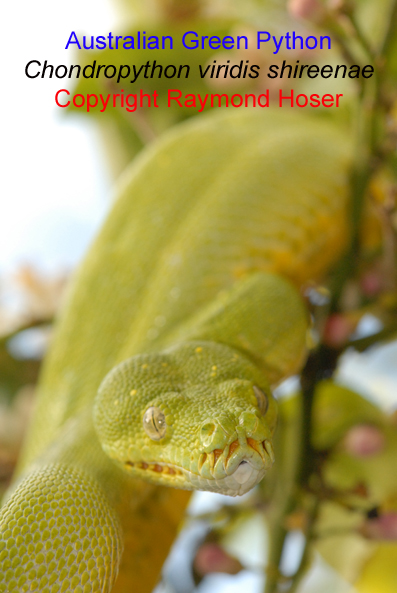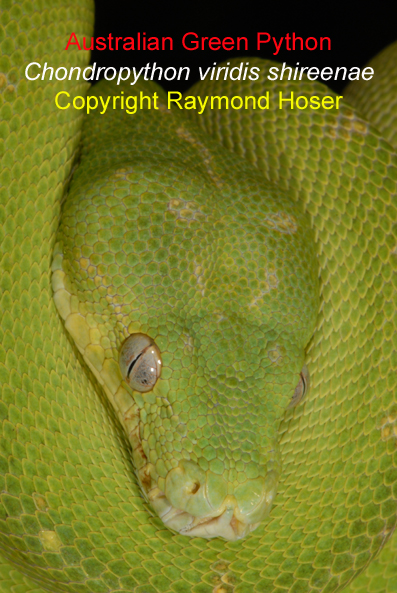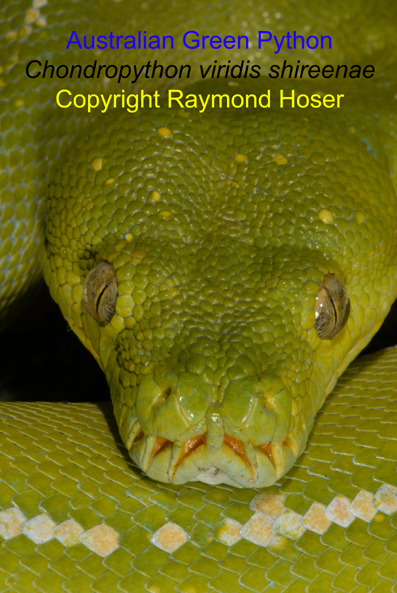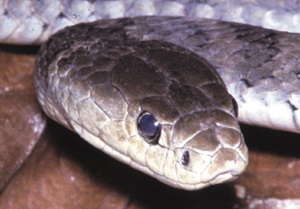|
AUSTRALIAN GREEN PYTHON |
CHONDROPYTHON VIRIDIS SHIREENAE SUBSP. NOV.
To view the full paper (Five New Australian Pythons)![]()
HOLOTYPE
(Details in the text below the photos)
Below are photos of Australian Green Pythons, Chondropython viridis shireenae sometimes called Morelia viridis shireenae in life.
An adult specimen (number D51862) held at the National Museum of Victoria (NMV), from "Cape York, Queensland" (The general Lat. Long. for Cape York is: 15°00' S, 143°00' E). The snake was not accurately measured due to the fact it was hardened in tight coils, however it was about 1 metre in total length.
Dorsally the snake was dark in colour (relative for the species C. viridis) and a generally uninterrupted colour dorsally, save for a thin line of lighter scales along the dorsal vertebra, having been a generally dark green in life.
Ventrally the holotype of Chondropython viridis shireenae sp. nov. was light in colour, (having been a yellow colour in life) and with some dark flecks on some scales (probably grey, black or green flecks in life).
The sex of the holotype of Chondropython viridis shireenae sp. nov. was not ascertained.
There were six pits in the lower labials and three on the upper scales of the mouth, towards the front of the head (these counts being for each side of the head).
The holotype of Chondropython viridis shireenae sp. nov. had 233 ventrals, divided anal and 65 (all paired) subcaudals.
Most of the scales on the dorsal surface of the head were small and almost granular in appearance and somewhat irregular.
The teeth were long and sharp.
The holotype of Chondropython viridis shireenae sp. nov. had been in captivity prior to being lodged at the museum as evidenced by the one or more domestic mice (Mus musculus) found inside the stomach of the snake (undigested).
The snake was collected on 20 June 1973.
DIAGNOSIS
Chondropython viridis shireenae sp. nov. are the only Green Pythons (C. viridis) found on mainland Australia and can be separated from all other C. viridis on this basis.
In the absence of good locality data, the subspecies is best separated from other C. viridis by comparative DNA analysis, which has already been successfully used to separate this subspecies.
Australian C. viridis have as adults, white or other markings along the vertebra and few other markings, whereas those from elsewhere do not always have this trait. Hence this is a diagnostic character for Australian specimens of C. viridis.
As a trend, vertebral markings decline with age. General dorsal markings, sometimes in the form of blotches and mid-dorsal markings are generally far more common in juvenile C. viridis of all subspecies, especially those from outside Australia.
The range of C. viridis shireenae subsp. nov. is only in very wet habitats of the lowlands and nearby range areas on the east side of Cape York from about the MacMillan River drainage in the north to the area around the Normanby River drainage in the south. This includes the Sir William Thompson and McIlwraith Ranges both in the general vicinity of the Iron Range National Park.
The known distribution of C. viridis in Australia is only on very restricted parts of the Cape York Peninsula and does not include the dry savannah habitats that adjoin Torres Strait or the islands within Torres Strait itself.
There is believed to be over 50 km (straight line measurement) between the northernmost C. viridis shireenae subsp. nov. and the northern tip of Cape York, bordering the Torres Strait, which includes generally unsuitable habitat for the subspecies.
In view of the lack of evidence of these snakes inhabiting this area within recent historical or recent prehistorical times, it is reasonable to infer that the Australian C. viridis have been separated from other populations for many thousands of years.
Furthermore, in view of the fact that other species of python inhabit these intervening areas and presumably compete with this species in the areas they coexist, it is reasonable to infer that there is not, nor has been any gene flow between the Australian and other populations of this species within recent historical or recent prehistorical times and perhaps as far back as or before Aboriginal settlement of Australia an estimated 40,000 years ago.
The 40,000 year date is significant as it is thought that habitats throughout much of Australia (including the north) may have changed significantly (become generally more open and drier) with the arrival of humans, due to the increased incidence of bushfires. Before the arrival of humans on the Australian continent, habitat may have allowed for gene flow between the Australian C. viridis and those populations to the north.
A search of likely habitats in the far north of Cape York and Torres Strait should be undertaken to confirm current distribution data.
Comparative DNA testing can separate Australian C. viridis shireenae from other C. viridis.
CAPTIVE HUSBANDRY
From a keeper’s point of view there appears to be no known differences in terms of keeping C. viridis shireenae and C. viridis from elsewhere.
These snakes require an enclosure with at least one horizontal tree branch or fork in which to perch and they need a humid environment when sloughing.
Eggs usually take from 38-60 days to hatch (extremes given) (Barker and Barker 1994).
Detailed husbandry information for this species can be found in Barker and Barker (1994), Ross (1978) and Ross and Marzec (1990).
Papers on breeding the species have been published by numerous authors including definitive papers by Murdoch (1999), Rundquist (1993), Walsh (1979) and Zulich (1990). Copies of the papers by Murdoch, Walsh and Zulich are available in full on the internet and can be found using any decent search engine, such as "www.yahoo.com".
ETYMOLOGY
Chondropython viridis shireenae sp. nov. is named in honour of my long suffering wife.
Shireen Vanessa Hoser has had to put up with long periods without me as I have conducted the research necessary for this and other publications and done an excellent job in terms of looking after and caring for our children in my absence.
THE ABOVE WAS FROM THE PAPER
FIVE NEW AUSTRALIAN PYTHONS
By Raymond Hoser
488 Park Road, Park Orchards, Victoria, 3134, Australia.
Phone: +61 3 9812 3322 Fax: 9812 3355 E-mail: adder@smuggled.com
Originally published in the Newsletter of the Macarthur Herpetological Society Issue 40, August 2003:4-9
To view the full paper (Five New Australian Pythons)![]()
 To download the original of this paper exactly as it appeared in printed form in The Newsletter of the Macarthur Herpetological Society -
to get the 2 mb pdf (Adobe Acrobat) file (it will take up to eighteen minutes to download).
To download the original of this paper exactly as it appeared in printed form in The Newsletter of the Macarthur Herpetological Society -
to get the 2 mb pdf (Adobe Acrobat) file (it will take up to eighteen minutes to download).![]()
 To download the same paper as above as an MS Word document (better for printing)
To download the same paper as above as an MS Word document (better for printing)![]()
 To download the entire newsletter that had this paper (exactly as printed and published)
To download the entire newsletter that had this paper (exactly as printed and published)![]()
To view the full text of a more recent paper dealing with the taxonomy of Green Pythons, including the formal recognition and diagnosis of two species and two subspecies for "Chondropython" group, click on the text below:
Below is an image of the species Tropidechis sadlieri
Click on it to read the paper about the species







